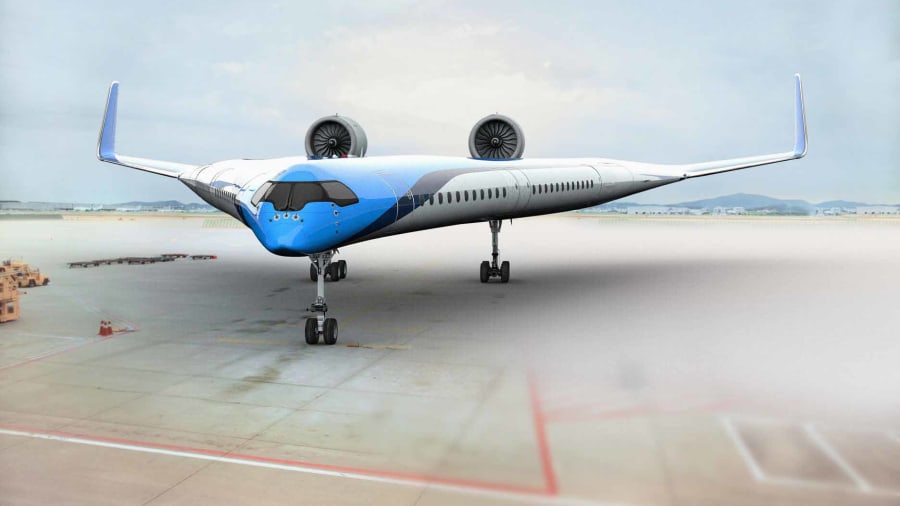|
Boeing har utviklet modeller, bl.a. X-48, av denne typen fly. Flere skalamodeller er også flygende. Mange vet veldig mye om konseptet som er langt fra nytt. (Red.)
KLM to fund
development of fuel-efficient Flying-V plane
 In the wings: Dutch airline KLM has agreed to fund development of V-shaped aircraft known as the Flying-V, which incorporates the passenger cabin, fuel tanks and cargo hold into the wings. (CNN) - The development of a V-shaped, fuel-efficient airplane design known as the Flying-V is getting a boost with the announcement that Dutch national carrier KLM Royal Dutch Airlines will help to fund it. Intended to improve the sustainability of air travel, the Flying-V was conceived by Justus Benad, then a student at the Technical University of Berlin, and developed by researchers at Delft University of Technology in the Netherlands, also known as TU Delft. Its futuristic design incorporates the passenger cabin, fuel tanks and cargo hold into the wings. The passenger cabin, fuel tanks and cargo hold are all incorporated into the plane's wings in the Flying-V design. It's claimed the plane will use 20% less fuel than the Airbus A350-900 while carrying a similar number of passengers -- the Flying-V will seat 314, while the Airbus A350 seats between 300 and 350. The design also mirrors the A350's 65-meter (213 feet) wingspan, enabling it to use existing airport infrastructure. "In recent years, KLM has developed as a pioneer in sustainability within the airline industry," Pieter Elbers, CEO and president of KLM, said in a statement. "We are proud of our progressive cooperative relationship with TU Delft, which ties in well with KLM's strategy and serves as an important milestone for us on the road to scaling-up sustainable aviation." TU Delft project leader Roelof Vos said such innovation was needed as a stepping stone to greater efficiency while technology was still being developed to create large-scale electric airplanes. "Aviation is contributing about 2.5% of global CO2 emissions, and the industry is still growing, so we really need to look at more sustainable airplanes," he told CNN. "We cannot simply electrify the whole fleet, as electrified airplanes become way too heavy and you can't fly people across the Atlantic on electric airplanes -- not now, not in 30 years," Vos said. "So we have to come up with new technologies that reduce fuel burn in a different way. "We've been flying these tube and wing airplanes for decades now, but it seems like the configuration is reaching a plateau in terms of energy efficiency," he said. "The new configuration that we propose realizes some synergy between the fuselage and the wing. The fuselage actively contributes to the lift of the airplane, and creates less aerodynamic drag." The plane's increased fuel efficiency is largely a result of its aerodynamic design, Vos explained, although its reduced weight also contributes. The researchers hope to fly a scale model this September, Vos said, while a mock-up of the new cabin design will be open to the public at Amsterdam's Schiphol airport in October, as part of KLM's 100th anniversary celebrations. The completed plane is expected to enter service between 2040 and 2050. The design still requires rigorous testing, Vos told CNN. "We've done numerical testing and preliminary wind tunnel tests, but we need to do much more testing in wind tunnels -- high speed and low speed -- to demonstrate that this airplane is efficient as we think." |
tirsdag 4. juni 2019
KLM vil finansiere utviklingen av ny type fly - Curt Lewis
Abonner på:
Legg inn kommentarer (Atom)



Ingen kommentarer:
Legg inn en kommentar
Merk: Bare medlemmer av denne bloggen kan legge inn en kommentar.